



 BY KEITH BURBANK
BY KEITH BURBANK
Kaiser Permanente has abandoned its proposal to develop medical offices on lower Potrero Hill. Previously planned for the corner of 16th and Mississippi streets, the health care giant will instead locate its expansion two blocks away, at 1600 Owens Street. The company faced stiff neighborhood opposition to its proposal to redevelop the Corovan site, but it said it changed locations so that it could open the medical complex two years sooner.
“I think it’s great that Kaiser recognizes that they’ll have a better project [if it’s not located] on lower Potrero Hill,” said Kepa Askenasy, co-founder of the neighborhood activist group, Save the Hill, which advocated for an alternative to the 16th and Mississippi streets location. Rod Minott, also co-founder of Save the Hill, agreed, adding that Mission Bay is a far more appropriate site. According to both co-founders, opposition to Kaiser’s 16th and Mississippi streets plans was fueled by a desire to stop the creep of Mission Bay-like development onto Potrero Hill.
Minott is disappointed that Kaiser isn’t locating in Bayview. A health facility in that neighborhood, Minott said, would help address medical disparities that exist between poor and wealthy neighborhoods, provide jobs to Bayview residents and stimulate economic growth. “But we’ll take the victory,” he said.
Minott’s research during the yearlong effort to stop the Kaiser development opened his eyes to health differences in Potrero Hill and Bayview. “We encourage them [Kaiser] to keep addressing that [the medical disparities],” Minott said. Minot said that health differences are apparent in rates of childhood asthma and diabetes in the two neighborhoods. “Bayview-Hunters Point residents are hospitalized more than residents of other neighborhoods for almost every disease, including asthma, congestive heart failure, diabetes, and urinary tract infections,” stated a 2006 San Francisco Department of Public Health report.
Kaiser’s planned medical complex in Mission Bay will bring the health care provider’s services closer to its Potrero Hill and Bayview members,
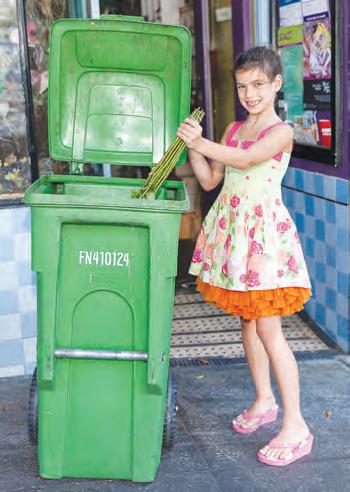

City’s Zero Waste to Landfill by 2020 Initiative Faces Challenges
BY ROBERT KRAUSZ
In 2003, the City and County of San Francisco passed a resolution which called for an end to all landfilling of waste within 17 years. The Zero Waste to Landfill by 2020 initiative emerged as one of the highest-profile elements in the municipality’s self-promotion as an international ‘sustainable city.’
However, with less than seven years left until the deadline, it’s almost certain that San Francisco will continue to depend on dumping garbage into holes in the ground far past its self-imposed deadline.
The looming failure may surprise San Franciscans. Civic representatives have loudly proclaimed the City’s success in diverting trash from landfills; diversion rates increased from under 50 percent in 2000, to more than 80 percent last year. “San Francisco is demonstrating once again that zero waste is an achievable and environmentally responsible goal,” said Board of Supervisors president David Chiu, in a 2012 press release from the Mayor’s Office. “I thank Recology and the Department of Environment staff who are reaching out and educating our residents and businesses to make sure they continue to recycle and compost our way to zero waste.”
According to the press release, the City’s diversion figure is the best among American municipalities,
Former State Senator Criticizes Proposed Green Benefits District
BY OMAR KHAN
Efforts to launch a “Green Benefit District” (GBD) have been met with lukewarm support from respondents to a recent survey, and sharp criticism from a retired state legislator. Under the proposed district, Dogpatch and Potrero Hill property owners would voluntarily pay a tax, the revenue from which would be dedicated to neighborhood green spaces. Just over half of the more than 600 survey respondents favor GBD formation, while 43 percent thought it was interesting idea, but felt that they lacked information about the concept. The survey, fielded by GBD advocates, has limited statistical accuracy, since it wasn’t administered randomly.
The Green Benefit District would be modeled after Community Benefit Districts (CBDs). CBDs allow property owners to voluntarily tax themselves, and direct the resulting revenues into a defined set of investments and activities. Under the GBD, funding would be dedicated to improving and maintaining existing green spaces - such as public parks and gardens - in Dogpatch and the Hill, and small capital improvements to prevent underutilization of open spaces, such as alleys, sidewalks, and underneath freeways. Improvements could include adding lighting, graffiti abatement, and landscaping.
Critics of the proposed district – prominently, retired State Senator John Burton, a Hill resident since 1964 - claim that GBD development efforts haven’t been transparent. “We were surprised to find out about the formation of GBD so late in the game,” wrote Burton in a May letter to the GBD formation committee chairs. Burton was also upset that City Attorney and Dogpatch resident Dennis Herrera and former Mayor and Hill resident Art Agnos weren’t consulted about GDB formation. “There is not that much awareness on the Hill. It is evidenced by the fact that less than 15 percent of the surveys that were sent out by mail,
FREE Serving the Potrero Hill, Dogpatch, Mission Bay and SOMA Neighborhoods Since 1970 AUGUST 2013
KAISER page 10 ZERO WASTE page 6 GBD page 4
Kaiser
for Medical Offices on Lower Potrero Hill
Abandons Plans
INSIDE Director Georgia Webb p.22 Supervisor Malia Cohen p.9 Muni Loop Project p.17 p.7 p.3 p. 23 p. 21
lighting, graffiti abatement, and landscaping.
ROBERT KRAUSZ
Improvements could include adding
The Skinny
BY JENNIFER P. ADAMS
The U.S. National Institutes of Health labels obesity as the second leading cause of preventable death in America. Fortunately for San Franciscans, with our health-crazed subculture of gluten-free everything, locavores and yoga hipsters, our City ranks number four on USA Today’s “Fittest, Healthiest Cities Across the Nation.” Although you don’t see many severely obese people here, there are lots of thin people with slightly larger bellies.
For the past decade health experts have drilled into our heads that being overweight is a recipe for future diabetes and a library of other diseases. But there’s more to the story. Mercedes R Carnethon, M.D., recently concluded from a series of experiments on diabetes that mortality rates are actually higher for diabetics of normal body mass index (BMI) than those that are obese. In an article published on PLOS One, Joseph P. Wilson and his fellow researchers point-out that these health risks are related to body shape. The thinner diabetics that had higher mortality rates had most of their body fat concentrated within their abdominal region, while diabetics with higher BMI had a relatively even body-fat distribution.
Researchers analyzed data from the Centers for Disease Control and Prevention’s National Health and Nutrition Examination Survey, in which Dual-energy X-ray absorptiometry, a medical imaging instrument, was used to measure body composition in a representative sample of Americans. They concluded that trunkto-leg volume is proportional to the risk of contracting metabolic diseases, such as diabetes, high triglycerides, high LDL – “bad” cholesterol – and many other heart diseases.
Regardless of your physique, if your waistline expands while your leg muscles atrophy your risk of getting the “Rich Man’s Syndrome” – diabetes – skyrockets. In addition, Constance E. Ruhl, MD’s 2010 research on trunk fat, published in the Journal of Gastroenterology, revealed that there’s a strong connection between trunk fat mass and abnormal levels of alanine aminotransferase, an enzyme that the liver releases in response to liver injury.
This evidence is distressing, especially for people of normal weight who have a genetic tendency of storing excess fat in the abdominal area or a family history of high cholesterol. But fortunately, the solution is a simple math problem: decrease trunk size, increase leg size. Hill residents with these characteristics can improve their diet by taking advantage of the neighborhood’s grocery stores that offer organic and seasonal vegetables, and chisel down their trunk and tone their legs with affordable yoga or CrossFit classes. If you’re on a tight budget, have fun planting your own hydroponic veggie garden, or repeatedly running the Hill’s infamously steep hills; full-body sweat in 15 minutes guaranteed. The answer to better health may just be around the corner.
Carolina Street Jennifer Adams resident attends Lowell High School. Steven Moss will be back with his views next month, assuming he has one.
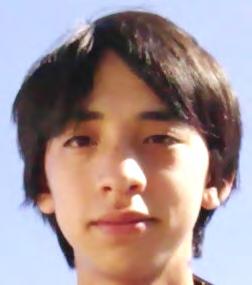


Ari Ichinaga, will be a sophomore at School of the Arts this fall. He spent three weeks doing a photography internship at the Potrero View —his second. The View thanks him for his excellent photos for the Capital Story and Monster Homes.
A Visionary Project For Potrero Hill
BY ROD MINOTT
Last month, Kaiser Permanente announced they were abandoning their proposed medical complex at the foot of Potrero Hill and relocating to Mission Bay. This welcome turn of events is a positive outcome for both the Hill and Kaiser.
Now that Kaiser has made their decision, what’s next for the 3.5 acre site at 16th, 17th, and Mississippi streets? For Save The Hill the answer is simple: “adaptive reuse.”
The practice of adaptive reuse – in which existing buildings are converted or rehabilitated for new uses – is well known in architectural and development circles. Fantastic examples exist in San Francisco, Seattle, New York, Los Angeles, and London. It’s an elegant solution that simultaneously preserves the history of urban neighborhoods while inspiring innovative new architecture and accounting for the demands of development and growth.
The site where Kaiser and its codeveloper were proposing a massive Mission Bay style medical and residential complex contains three industrial buildings with a storied history. Dating as far back as 1905, these buildings were once home to pioneering steel company Pacific Rolling Mill. Steel fabricated at the site helped rebuild San Francisco after the Great Earthquake and Fire, and also provided the structural bones of some of the City’s most striking
architectural monuments, including Grace Cathedral, The Flood Building, and parts of the Golden Gate Bridge. An adaptive reuse project would rehabilitate this historically significant site while enhancing the neighborhood’s character and economy. The site at 16th and Mississippi streets is a “gateway” location to the community that has the potential to become an iconic signature for Potrero Hill. The revitalized complex could contain a mix of uses that would truly serve our neighborhood – small offices, local retail shops, restaurants, light manufacturing, and possibly even a school. A similar and striking project is underway at Pier 70, where several industrial buildings along 20th Street are getting an exciting new life. Similar to Pier 70, financing can be accomplished through developer equity, tax credits, incentives for historic building rehabilitation, and City funding.
The yearlong Save The Hill campaign on which I and nearly 2,000 other petition signers worked diligently was fueled by a vision of what could be better, inspiring, and unique. We entreat the site’s owner, Walden Development, to work with residents to make the “Potrero Hill Gateway” project a reality. This is do-able. It’s a plan we believe both Hill residents and City officials can embrace, support and take pride in.
For examples of adaptive reuse projects visit www.savethehill.com/ reuse.html.
Robin Fierberg, a resident of Potrero Hill, will be a sophomore at International School this fall, and spent three weeks doing an internship at the Potrero View — his second summer. He’ll be spending the rest of his summer doing a film and production class. A huge thank you for your amazing computer skills and being able to figure out anything that’s handed to you.
Ryan Johnston, a New York native who grew up on Long Island, N.Y., received his Bachelor’s degree in Communication Arts from Marymount Manhattan College in 2012. Currently, he lives in San Francisco and attends San Francisco State University for his Master of Arts degree in Broadcasting and Electronic Communication Arts. Ryan spent June and July doing an advertising internship with the paper. The View thanks Ryan for his perseverance at pounding the ...



2 THE POTRERO VIEW August 2013
OP / ED
Summer
™
design by
Patri THE VIEW IS PRINTED ON RECYCLED NEWSPRINT WITH SOY-BASED INK. EDITOR and PUBLISHER Steven J. Moss PRODUCTION MANAGER J.Durrant AUGUST CONTRIBUTORS Jennifer P.
Editorial and policy decisions are made by the staff. All staff positions are voluntary. Published monthly. Address all correspondence to: THE POTRERO VIEW, 2325 Third Street Suite 344, San Francisco, CA 94107 415.626.8723 • E-mail: editor@potreroview.net • advertising@potreroview.net (advertising) Copyright 2013 by The Potrero View. All rights reserved. Any reproduction without written permission from the publishers is prohibited.
= Interns at the View
Masthead
Giacomo
Adams, Lynne Barnes, Keith Burbank, Deepti Diwakar, Kerry Fleisher, John Gallagher, Ron Harrison, Ari Ichinaga, Abigail Johnston, Robert Krausz, Sasha Lekach, Catie Magee, Daphne Magnawa, Francisco Mattos, Liz Melchor, Rod Minott, Don Nolte, vBill Slatkin, Mauri Schwartz
GUEST EDITORIAL

SHORT CUTS Letters to the Editor
Editor,
In last month’s View a letter to the editor appeared opposed to the Kaiser project, and accusing the paper of misquoting the letter writer. That correspondence was written by someone who is working for a company that’s being paid by Kaiser to do acoustics work for the entire project! It takes something for someone to call your reporter “horrible” for allegedly misquoting him, but then not owning up to the fact that he’s being paid by the giant health care provider while he advocates on its behalf!
I moved to Potrero Hill last fall. I was made aware of the possibility of a Kaiser facility when I purchased my condominium, but since moving in and getting involved with the neighborhood, I can see where this facility was not right for the area!
I love it here. Arch, Bottom of the Hill, Front Cafe, Waterfront Automobile, and more; they make it here as small businesses with the support of those who live here! The Corovan facility, in my opinion, and at least 2,000 other residents, should be turned into more small business establishments that flow with the spirit of the area.
16th Street Resident

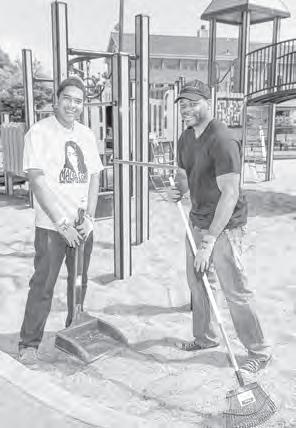

Shootings
Two people died and a third was injured in a shooting and possible stabbing at a jewelry store located at 888 Brannan Street last month. After being called, police encountered 23-year-old Barry B. White, Jr. covered in blood on the north side of the street. White pulled a gun and fired at them, while retreating to a nearby restaurant, before apparently running out of ammunition and surrendering to police. At Victoga Inc., a jewelry store in the GiftCenter & JewelryMart , two females were found dead from either gunshot or stab wounds. A male victim also suffered from gunshot wounds, and was taken to San Francisco General Hospital (SFGH) in stable condition…An unidentified man was injured in a shooting near the corner of 23rd and Arkansas streets on July 20. The victim was transferred to SFGH with non-life-threatening injuries. He refused to answer questions about the incident.
No Color
Cenveo, which offers large-scale print production services, will close its Dogpatch location, ColorGraphics, by the end of this month after 35 years of operation. ColorGraphics is liquidating its equipment, which includes a handful of sheet-fed presses, and Cenveo has moved remaining print jobs to a Los Angeles branch, according to San Francisco plant manager, Frank Brunini The 69-person staff has already been reduced to less than 25, with just shipping and maintenance workers remaining. Staff was given no notice of the closure, and will receive severance based on tenure. ColorGraphics’ 888 Tennessee Street lot and building were sold about eight months ago, but the plan had been to maintain operations until a lease ran out in 2016. Ongoing declines in demand for the printing
press industry, precipitated by general economic factors as well as the rise of non-industrial multimedia applications, contributed to Cenveo’s decision to close the plant early. Brunini only had three days-notice himself, and has helped four or five employees find other work so far. “Some of our workers have been here for 25 years,” he said. Cenveo didn’t return calls or emails from the View, and as a result no information was available for plans for the building. “Talk is that this office will be somebody’s bedroom soon,” Brunini said. Brunini has a softspot for Dogpatch; his father worked in the American Can factory on Third Street building torpedoes during World War II. “I guess this is really the only direction left for growth and development. For the past couple years it’s been like a wave of enormous cranes just moving a different lifestyle further and further down here.”
No Parking
Last month new parking restrictions were imposed on Illinois Street. In addition to Monday and Wednesday street cleaning, parking is now prohibited from 2 a.m. to 6 a.m. daily, essentially banning overnight parking…An independent film was recently shot on Vermont Street. Quitters is the story of a teenage boy who, disgruntled with his parents, runs away from home. He moves in with his girlfriend at her parents’ house, seemingly for good. The movie’s actors include Mira Sorvino, Greg Germann and Kieran Culkin. “It’s been a long and winding road,” said Debbie Brubaker, line producer for the movie, which is being produced by Frederick & Ashbury, LLC. The production team wrapped up filming on July 11, after 31 days, four to nine days longer than is typical for an independent film. According to Dan Kemp, the film’s location manager, some Potrero Hill ten-
ants and homeowners were paid for the use of their property, which invovlved filming inside their homes. Besides the Hollywood stars, most of the cast and crew are from the Bay Area. Moviegoers can expect the film to be theaters in about a year.
Family House
Family House, Inc. plans to develop and operate a new building on Block 7 East at Mission Bay. The new complex, located near the new University of California, San Francisco (UCSF) Benioff Children’s Hospital, will enable the nonprofit to more than double its capacity to house low-income families of children being treated at UCSF. The new building is expected to open in 2015. Since 1981 Family House has provided cost-free, temporary housing for out-of-town families with children undergoing treatment for cancer and other life-threatening illnesses…According to District 10 Supervisor Malia Cohen plans for a two-story 100-bed homeless facility next to Mother Brown’s resource center, at 2111 Jennings have been dropped. “After a thoughtful and engaging community process an agreement has been reached to not move forward with the proposed shelter at this time,” Cohen stated.

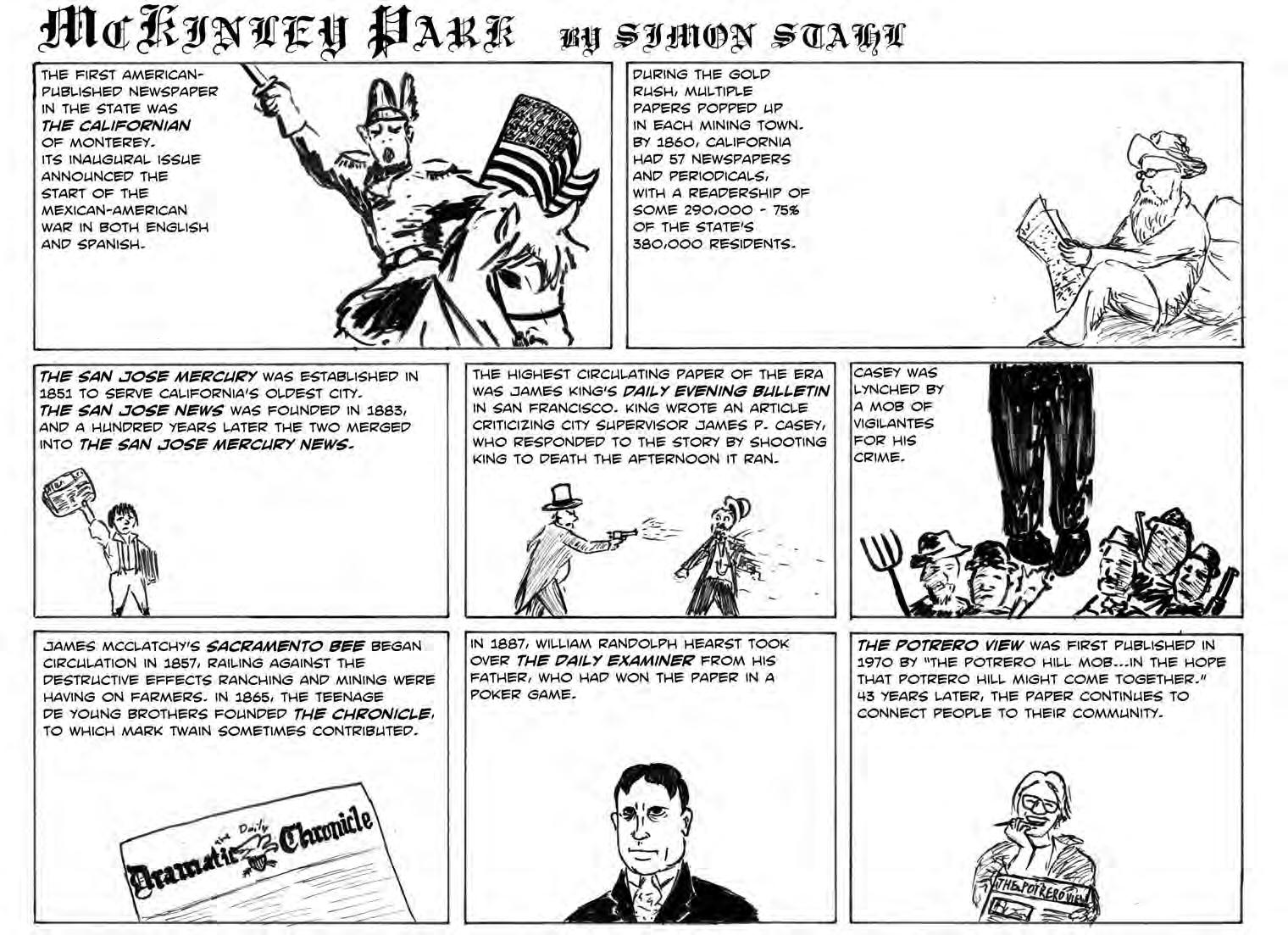
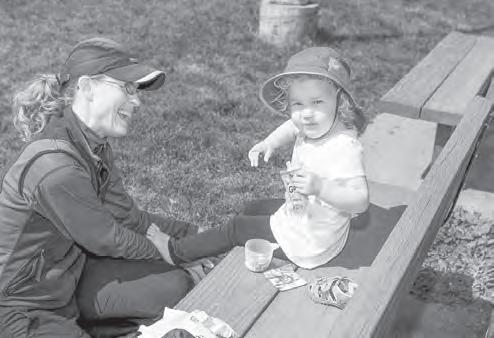
3 THE POTRERO VIEW August 2013
DAPHNE MAGNAWA Downed Power Lines on Utah Street.
McKinley Park
GBD from cover
not counting those handed out on the streets or available at community sites, were returned,” he wrote.
“15 percent is actually a very good response for a survey, though not enough to inform the neighborhood of the process” said Jean Bogiages, co-chair of the GBD formation committee. “But the process is ongoing to get more information. The important thing about this that everything about our organization will be contained in the management plan. We believe in giving full transparency.” GBD organizers will be hosting public workshops to gain community input later in the year.
The Green Benefit District would be modeled after Community Benefit Districts.
In addition to transparency, Burton is concerned about the GBD formation committee’s funding sources. “The primary funding is coming from developers who want to develop and potentially change the character of the Hill,” he wrote. “Under the guidelines of the benefits district, those who advance the money have the first call on any revenues raised by the tax assessment to have it paid back.” Developers AGI Capital/Avant Housing, Related California, and 650 Indiana Investment, LLC are currently the largest contributors to the effort.
Potrero Hill has a history of secretive efforts, including related to green spaces. In 2009 a new board was elected to govern Starr King Open Space in the wake of allegations that upwards of $100,000 had been stolen from the open space’s accounts. In 2007 in a deal brokered by then District 10 Supervisor Sophie Maxwell, TMG Partners contributed $1.5 million to a newly-formed Eastern Neighborhoods Public Benefits Trust Fund (ENPBTF) in return for a waiver of parking space requirements at 650 Townsend Street, now occupied by Zynga. According to Burton, community members directing the funds have been reluctant to disclose their decision-making process, or how the monies have been disbursed. Three GBD supporters – Dogpatch resident and real estate consultant Joe Boss, Potrero Hill resident and Potrero Hill Association of Merchants and Businesses present Keith Goldstein; and Dogpatch resident and Dogpatch Neighborhood Association (DNA) founder Susan Eslick – served as ENPBTF advisors.
The GBD formation committee has raised $207,850, with most of the financial support coming from developers with projects in Dogpatch and the Hill. Donors include Related, which has proposed to construct 320 apartments on 1601 Mariposa Street, and has provided the formation committee with $20,679; and Avant Housing, which wants to develop a 258-unit complex at 1201 Tennessee Street, and has contributed $21,319. Daggett Place, a residential project on 1000 16th St that includes .9 acre public park along the Daggett Street, Kaiser Permanente, which wants to develop a medical complex in Mission Bay, and Touchstone Commercial Partners, who are developing at 2051 Third Street, have also contributed to the effort.
The Green Benefit District is being developed by activists from the Potrero Boosters and DNA, in consultation with UP Urban, a San Francisco-based nonprofit real estate development firm formed by Build Inc. Last year the Boosters and DNA voted to establish a formation committee to guide GBD creation. The GBD’s leaders include Bruce Huie, a long-time Dogpatch resident who helped establish Progress Park on Indiana Street; Jean Bogiages, who has been instrumental in developing green projects along Utah Street; and Tony Kelly, who recently stepped down as Booster president after serving for almost a decade, and who received the second most first place votes in the 2010 election for District 10 Board of Supervisors election.
The GBD would be the first of its kind in California. In order for it to launch, a management plan will be written by MJM Management, an urban development firm that’s worked with specially assessed districts, in consultation with the formation committee. The management plan will detail, among other things, the GBD’s spending authority, the types and extent of projects to be undertaken, the organizational and salary structure of its staff and director, and its boundaries, thereby establishing which residents would be subject to it. After the plan has been created, it would need to be petitioned onto the ballot with 30 percent +1 support of the property owners within the district. Once on the ballot the GBD need to be approved by simple majority. As of June MJM and CMG, a design and services management company, have billed GBD nearly $56,000.
The formation committee fielded its survey to gather data from which to develop the GBD’s management plan. “You just have to get ahead of it,” said Huie, referring to the tsunami of development and construction taking place in the community. “It’s better to establish these spaces now than to try when our population out here in Dogpatch has tripled.”
Dogpatch and Hill residents cherish their green spaces, which range from the 18th and Rhode Island permaculture garden to Starr King Open Space. Much of the elbow grease and funds to support local gardens and impromptu parks has come from community members, sometimes with assistance from public grants and private foundations.
“People want walkability” said Hiue. Three-quarters of those surveyed
wanted more pedestrian-friendly areas. Almost an equal percentage said that they’d like to see enhanced lighting in parks, green spaces, streets, sidewalks, and public stairs. More than half said that greening of communitymaintained spaces and gardens was necessary. And almost two-thirds of survey participants said that developing large scale parks and plazas within existing public spaces - such as converting a dead end street into a public garden space - should “definitely be a high priority.“
According to Bogiages the amount each property would be taxed within

the district will be based, in part, on survey results. In essence, the levy would be determined by what residents say they’re willing to pay. Bogiages added that the GBD’s exact boundaries will be decided this month, and all residents located within the GBD would be required to pay the tax, which would be collected through semi-annual property tax bills and paid directly to the City Tax Collector. The GBD would be structured as a 501(c)(3), subject to the same reporting, accounting, and public transparency requirements as any tax-exempt organization. Top
Ten GBD Contributors
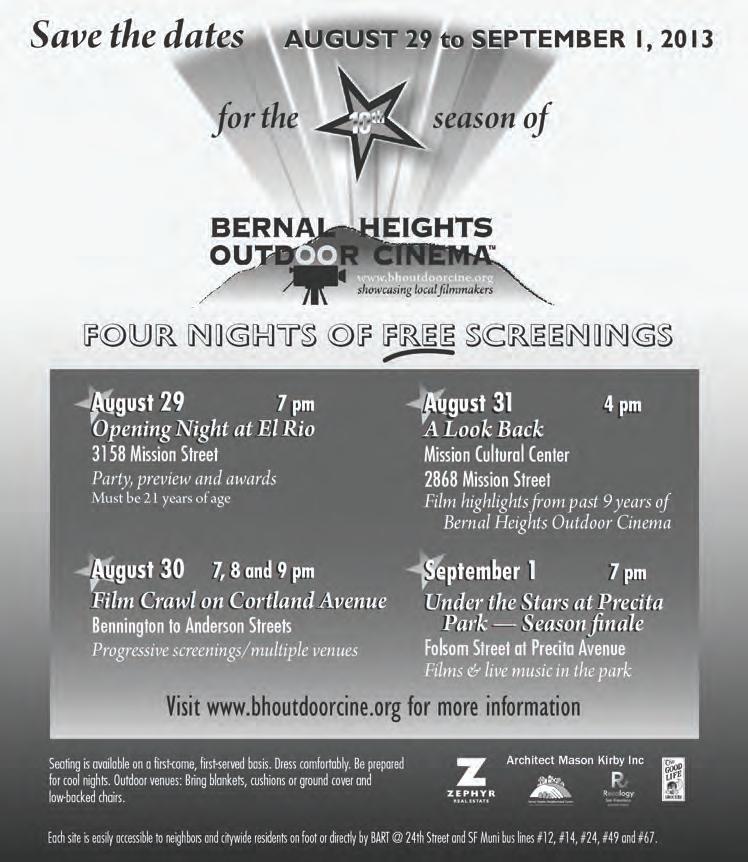
4 THE POTRERO VIEW August 2013
$ San Francisco Foundation 50,000 AGI Capital / Avant Housing 21,319 Related Companies 20,679 650 Indiana Investment LLC 7,817 Trumark Urban 7,178 Avalon Bay (contribution 1 of 2) 7,106 Walden Development 7,100 San Francisco Opera 5,000 David Baker Architects 3,000 Millwheel North, LLC 3,000 TOTAL 132,199
READ THE VIEW ONLINE potreroview.net
Rapid Development Perceived as Double-Edged Sword
BY KERRY FLEISHER
Not long ago Potrero Hill was a working class neighborhood with a thriving artistic edge. Today the community clings to its small town flavor while experiencing a changing demographic mix. Typical residents now include a thirty-something couple who commutes to high-tech jobs in Silicon Valley; an elderly neighborhood activist; and a lawyer who carpools his kids to private school. All share a love of the Hill’s sweeping views and the peculiar quaintness that comes with medium density living in a bustling city like San Francisco.
Hill residents have a mix of attitudes towards the new developments shooting skyward in and around their community. Infill development in the area is marching onward unabated: according to the recently approved 2014-2023 Capital Plan, 6,000 housing units are planned for Mission Bay, 3,400 for the new Transbay Terminal, and 12,000 for Bayview-Hunters Point. While growth may be inevitable in highly-prized San Francisco, Hill residents’ feelings toward the brick-and-mortar expansion range from delight, to cautious optimism, to concern.
Many residents are worried that new development will trigger increased traffic congestion, with public investment in transportation upgrades already lagging. “Development has been brought to the limit, it’s already slightly beyond what the Hill can handle. In terms of driving a few blocks, it can take 20 minutes at certain times of the day; it’s insane,” said Richard Shapiro, a physics high school teacher who lives on Arkansas Street.
Hill resident Barbara Schrader is also concerned about the threat of increasingly clogged roadways. When Mission Bay was undeveloped, she took her kids there to bike around, something she wouldn’t do today because of the hectic traffic. About 40 percent of planned high-technology office space has been constructed in Mission Bay. When fully realized, Mission Bay’s 4.4 million square feet of office space will draw in thousands of additional workers commuting by car, Caltrain, Bay Area Rapid Transit, and Muni.
Sarah Lerhaupt, who recently bought a North Slope property with her husband, expressed the common sentiment that transit options are already lacking on the Hill. “There is a weird premium to living in Potrero. Our cost of living is just as high as other people in the City, and yet we are under-served by Muni lines.” The Capital Plan acknowledges the gap, noting, for example, that the 22-bus needs to be extended to Third Street. But no funding has been allocated to do so.
Although transportation access is a dominant concern, residents also see upsides to the new development. Sam Vitkoski, a real estate agent who has lived on Missouri Street since 1986, believes the University of California-
San Francisco (UCSF) Mission Bay campus has revitalized the area. “In my view, having the UCSF is great. There’s jobs for people and there’s businesses coming there.”
Schrader, who works at UCSF’s Parnassus campus, is looking forward to being transferred to UCSF Mission Bay and walking to work. Many Hill residents take advantage of UCSF Mission Bay’s state-of-the-art gym.
Mission Bay’s design and scope, however, leaves residents puzzled. “I’m not trying to make an anti-development stance. You just can’t put in countless thousands of new units and the destination of three hospitals all in one spot,” said Shapiro. Lerhaupt also questioned the design. “I want to see more smaller mixed use buildings around transit. Mission Bay was built up at a mega urban scale and not human scale. You get a lot of charm when you have buildings at different scales.”
Many long-term Hill residents are wistful for quieter days. “It’s changed dramatically. It was nice when it was a sleepy little neighborhood and it was somewhat isolated and less people came through,” said artist Nancy Rodger, Shapiro’s wife, who described how there were only two cars on their street when they moved there in 1978. “We were just driving back to Potrero Hill and commenting how congested and ugly it’s becoming,” she added. “Mission Bay has changed the flavor: that style of building and density is cleaving Potrero Hill. It’s getting squished by big buildings encroaching on it.”
While some long-term residents feel that “sleepy” Potrero Hill is being eclipsed by new development, newcomers – some arriving from even more urban City neighborhoods – continue to be attracted by the Hill’s slower pace.
“Potrero Hill is a sleepy neighborhood people aren’t aware of, and it’s growing rapidly,” said Jessica Choi, who has rented on Arkansas Street for six years and works at Apple in Cupertino.
“It’s a gem in the City that a lot of San Franciscans haven’t been to.”
Vitkoski ranked the Hill’s low-key ambiance as one of its main draws.
“People that come to Potrero Hill tend to want to stay. It has a neighborhood feel; it’s out of the City but in the City,” he said, adding, “if you are commuting, it’s easy to commute to the South Bay.” Buyers routinely cite the Hill’s accessibility to the South and East bays, the Mission and Downtown as a significant part of its appeal. “One of the main draws of Potrero Hill was its accessibility to Caltrain and easy walking access for my daily commute to Palo Alto,” said Gary Lerhaupt, Sarah’s husband. For Silicon Valley Caltrain commuters who want medium density living, Potrero Hill is the obvious choice, with forty percent the density of South-of-Market.
Renters also seek out Potrero Hill for its accessibility to job nodes across the City and region. “I’ve worked in the City, Oakland, and South Bay and Potrero Hill has strategically always been a good location,” said Choi, whose boyfriend owns Wise Sons Jewish Delicatessen in the Mission, which, unfortunately for its fans in the neighborhood, has no plans to open another location on the Hill. When
asked if she’d consider buying property in Potrero, Choi said: “Hopefully one day I would definitely consider Potrero Hill for the commute and the ‘Mishpot,’” referring to the new nomenclature describing the area where Mission borders Potrero Avenue.
The Hill’s demographics may appear to be getting younger on 18th Street, symbolized by a latest crew of fresh faces at Farley’s, including the new owner, son of long-time proprietor Roger Hillyard. The data, however, indicates that in-migration of twentyand thirty-somethings isn’t offsetting overall aging trends. Based on a View analysis of U.S. Census data and the San Francisco Planning Department’s 2011 Socio-Economic Profiles report, from during the 2000 to 2010 the number of Hill residents between the ages of 18 and 34 fell five percent, residents between 35 and 59 grew two percent, and the more than 60 age group grew four percent. The number of children and teenagers stayed roughly the same.

meantime, are staring down rising real estate prices while having to jockey for houses in short supply. “It’s very difficult to buy a single family home on the Hill,” said Vitkoski. “There aren’t many available. When they do come available, they sell quickly.” According to Schrader, it’s a tough reality for her mid-twenties children who feel priced out of the neighborhood they grew up in.
Though Hill age demographics are holding fairly constant, nearby developments are creating a population of younger patrons drawn to the Hill’s commercial corridor. “You see large numbers of young vibrant people, which is nice to have around,” said Shapiro. “There’s human revitalization of the area.” Many of the Hill’s younger residents also welcome nearby growth because the higher density supports thriving commercial corridors in Dogpatch and Mission Bay. “The recent surge in investment around the area is great,” said Gary Lerhaupt. “It would be great to have more restaurants and nightlife options around the area,” he added.
Higher residential density has been shown to catalyze investment in local stores. “Potrero Hill is like the hill of one of everything,” said Sarah Lerhaupt, yet there’s no bakery serving fresh bread. Vitkoski noted that the Dogpatch still lacks a grocery store, though at least one is planned along Third Street. According to Randall Bartlett’s Testing the ‘Popsicle Test’, a neighborhood would have to be five times as dense as the typical American central city to support a retail bakery without demand from patrons living in other neighborhoods. Residential development in Mission Bay and Dogpatch is likely to spur more retail investment in and around Potrero Hill, zoning permitting.
Nearby development is also likely to increase the resale value of existing homes. “Study after study has shown that local-scale accessibility — the ability to take short trips to nearby shops — as well as regional accessibility to jobs and professional services are both significant in increasing home values,” said Fletcher Foti, manager for transportation applications at Berkeleybased Synthicity, an urban development software start-up. “Theoretically if you are going to add amenities to a place — such as new parks, grocery stores, new jobs, and new bus lines — generally the property values are going to go up,” agreed Synthicity’s Ian Carlton, manager of real estate applications.
Prospective homebuyers, in the
Local businesses can also feel the pinch. “Gentrification is almost always a double-edged sword. It can bring in amenities— like that new ramen shop you’ve been craving— while driving out other amenities, like the Laundromat you’ve been using for the past ten years,” said Foti. As reported in the View’s February 2013 issue, Potrero Coin Laundry has recently been subjected to a significant rent increase, which may ultimately force it to shutter.
One thing doesn’t seem to be changing in the community: Hill residents’ dedication to civic engagement. Roughly 2,220 community members have signed up on NextDoor Potrero, a San Francisco-based social media network, compared to 620 in the Mission, 170 in Mission Bay, and 720 in the Dogpatch. Discussions on the website can veer from deep debates about a proposed Green Benefit District, to healthcare recommendations, to scaffolding advice. One subgroup, “Save The Hill!” which successfully opposed the proposed Kaiser medical complex at 16th and Missouri streets, has upwards of 225 members.
Improving the quality of nearby public schools is one cause with broad support among Hill residents with young children. The Capital Plan noted that school facilities need to be reorganized and expanded as demographics shift. According to Stacey Bartlett, Potrero Kid’s administrative director, under the modest assumption of one child per every four units being developed, roughly 2,500 children will be added to Hill environs. “We can’t even fit kids we have in this attendance area,” she said. “I find it ironic that the City attempting to be one of the greenest on earth is bussing their students across town to get high quality education.”
Sarah Lerhaupt would appreciate the opportunity to send her future kids to a nearby public school. “It would be really hard to stay on the Hill if I had to drive my kids to school somewhere else or bus them safely elsewhere,” she said.
This is the second installment in a two-part series about capital investments in and around Potrero Hill.
5 THE POTRERO VIEW August 2013
ARI ICHINAGA
“…setting national recycling and compost rate records as the highest of any city in North America. It’s been accomplished through significant expansion of the City’s recycling programs, which have removed increasing amounts of trash from landfill disposal.” However, the percent diversion statistics paper over a number of trends that will make it difficult – perhaps impossible – for San Francisco to reach its ultimate zero waste goal.
The amount of waste generated per capita in the City actually increased between 2003 and 2011, the most recent reporting year: from 12.5 to 13.2 pounds per person per day. While per capita waste to landfill has declined over the initiative’s life, from five to 2.9 pounds per person daily over the same period,
goal was initially proposed. The policy adopted then was that the best use of any discarded material would be promoted, with ADC to be counted towards diversion credit if no better use was available. A decade later, Department of Environment’s Kevin Drew cited market volatility as a reason why some materials end up as ADC. Drew acknowledged that San Francisco relies on ADC to meet is landfill reduction goals, adding that the City is working with Recology to eliminate ADC use, and calling for the state to pass legislation that would ban the practice outright. In the meantime, the public is being told that San Francisco is leading the nation in redirecting waste from landfills when much of what’s being reported as diverted is actually still ending up in the dump.
The need to landfill part of the waste strem is the result of the manufacture of products that are made of problematic materials, such as plastics and composites.
it hasn’t dropped as much as the percent diversion statistics imply, because the increased diversion rate has had to overcome the much-less-publicized rise in the total quantity of waste generated.
Further, the 2.1 lb/person/day capita decrease in waste to landfill consists of the ‘low-hanging fruit’ of garbage that’s been diverted through the introduction of mandatory composting and recycling, and the expansion of items that can be put into green or blue bins. The remaining 2.9 lb/person/day is made up largely of waste that continues to defy attempts to avoid landfilling.
Waste stream data reported by local governments may be misleading. For example, Alternative Daily Cover (ADC) consists of waste material used instead of soil to wrap the active face of the landfill at the end of each day, as a way to control fires, odors, blowing litter, and scavenging. The California Department of Resources Recycling and Recovery allows a wide variety of materials to be dumped in landfills as ADC, including ash and cement kiln dust, treated automobile shredder waste, construction and demolition waste, compost, green material, contaminated sediment, sludge, and shredded tires. All of this stuff is credited as waste diverted from landfill; a case of garbage accounting that might seem dishonest, yet is a perfectly legal, state-sanctioned practice that occurs in communities across California.
The amount of ADC San Francisco sends to the Altamont landfill has fluctuated wildly over the past decade, jumping from as low as three percent to as high as 19 percent. Since the nature of materials in the waste stream tends to remain similar from year to year, there’s no obvious reason why ADC levels should rise and fall so sharply and haphazardly, suggesting that variations in the number may be the result of ADC being used as a way to ‘fudge’ the data, to produce statistics that the City can use to promote its performance on waste reduction.
The Board of Supervisors acknowledged the ADC problem in 2002, when the concept of a zero waste to landfill
It’s also unclear whether waste that’s deposited into blue bins, which the City counts as being diverted from landfill, is fully recycled. A significant portion of this material likely winds up in dumps, due to inherent inefficiencies in recycling collection and sorting systems. Non-recyclable contaminants, such as bags of dog poo and still-full pop bottles, can go undetected until they’re spotted at Recology’s sorting center. By then they may have contaminated a large amount of the collected material, rendering it all unrecyclable.
With fluctuating markets for recyclates, some of the successfully sorted materials might still end up consigned to the landfill, as too-low prices or an absence of buyers for bales that are piling up can make dumping the default alternative option. And there’s little tracking of what eventually becomes of what does get traded past the center’s gates; existing regulations don’t require comprehensive accounting for materials that have been off-loaded by Recology. Offshore locations are often the final destination, places where poor environmental and labor standards may prevail, turning San Francisco’s waste problem into a far-reaching social justice one.
Although City Hall continues to follow the general storyline that San Francisco is on track to achieve its zero waste to landfill goal, it’s difficult to find an official who will guarantee that will happen by 2020. “We're shooting for 2020, but until we get closer it is rather unnecessary to speculate,” said Drew. “The task at hand is to keep working on diversion, product redesign and bans and an overall reduction in generation.” Recology’s Robert Reed asserted that the zero waste to landfill goal will ultimately be achieved , while acknowledging that it won’t happen under current policies.
Promotion of the zero waste campaign has focused almost exclusively on percent diversion from landfill, with little attention to addressing the nature of what becomes waste in the first place. San Francisco’s efforts to cope with the “top-of-pipe” has mostly come in the form of ordinances which target a small portion of the overall waste stream. The City launched its high-profile plastic bag ban, for instance, in 2007, with large supermarkets prohibited from distributing plastic bags at checkout. In 2012, the ban was expanded to cover
all retail shops and restaurants. While the ordinance has garnered much media coverage, and positive comparisons to other cities that haven’t enacted similar policies, plastic bags continue to be a part of the City’s waste landscape because the ordinance – even its stricter revised version – provides for expansive exceptions, including allowing bags used for bulk items, produce, nuts, grains, candy, meat, fish, and small hardware; bags used to separate items to avoid damage; bags from pharmacists to contain prescription drugs; newspaper bags; and, even laundry or dry cleaning bags. And the City allows shoppers to buy plastic bags that are similar to the ones they used to get for free, presumably to support such intractable habits as lining household waste baskets, or picking up Spot’s poo from the sidewalk.
The need to landfill part of the waste stream is the result of the manufacture of products that are made of problematic materials, such as plastics and composites, and that are designed for disposability and rapid obsolescence instead of durability and reuse. No amount of recycling of such products can achieve independence from landfilling; even incineration results in significant amounts of residuals which require landfill disposal, as well as associated problems of toxic fallout.
Problematic materials and poor design are inherent in myriad products upon which modern society depends. Cars, computers and other electronic devices, food packaging, household products, and even life-saving medical devices, among other items, are all non-divertible, landfill-dependent waste. Achieving the goal of zero waste to landfill would require a wholesale change in behavior that eliminated all such products, which is unlikely to occur by 2020 nor anytime soon after.
According to a three-year research project conducted from Lincoln University in New Zealand, All for naught: A critical study of zero waste to landfill initiatives, no municipality, anywhere in the world, has managed to end dependence on landfilling waste. What sets San Francisco campaign apart from other efforts, according to the study, is that the City’s politicians, environmental staff, and Recology have loudly and publicly postured that the goal is achievable. Yet both the City and Recology are fighting to secure a new contract under which San Francisco’s residual waste would be shipped longdistance to Yuba County, to a landfill site owned by Recology, until 2025 or thereabouts, five years beyond the date when, under current policy, landfilling will no longer be necessary.



6 THE POTRERO VIEW August 2013
ZERO WASTE from cover Nail Service Waxing Facial Tinting Massage Hair Cuts 640 Texas St. 415.920.9888 Store Hours Mon-Fri: 10am - 7:30pm Sat-Sun: 10am - 7pm Oct. - Mar. closed Mondays Email quincespa@quincespa.com QuinceSpa.com
PHOTOGRAPH BY EMILY PAYNE

FIRE ON SAN BRUNO STREET —
A fire broke-out at 742 San Bruno Street last month, possibly caused by arson. Roger and Susan Jones, along with their two children, Ian and Elizabeth, live in the home. The fire burned the back staircase and upstairs balcony, rendering the structure uninhabitable. The Red Cross assisted the Jones’ in securing temporary odging The family has been Hill residents for more than two decades. RON
Acupuncture Works…

New Patients: $30 for first visit
Returning Patients: $10 off next treatment
Children’s TV Show Casts Story by Former Flynn Elementary Student
BY KEITH BURBANK
A national children’s television show created a short film from a story by a former Flynn Elementary student. “Carrot Unicorn,” written by Zoe Burleson – now a seventh grader at St. Paul Elementary School – was made into a short by Green Screen Adventures (GSA), a children’s show aired on weekend mornings. “Carrot Unicorn” was first shown on GSA last fall. “It’s awesome,” said Zoe’s mother, Amanda Burleson, who added that she’s very happy for her daughter. “Very cool. Very exciting.”
According to Burleson, her daughter started reading at a late age. But once she started to read, she dove into writing. Zoe was particularly drawn to Archie comic books and graphic novels, which in turn inspired her writing. Burleson said that her family, which lives in Noe Valley, has never been big on electronic toys, and doesn’t have any video game consoles. If Zoe didn’t want to play outside, Burleson or her husband, Richard Rocha, told her she could read or write. “She’s nurtured that and hasn’t stopped writing,” Burleson said. Zoe has many notebooks full of stories, poems and comics she’s written. “She’s working on a novel,” Burlson added.
Burleson said it was Zoe who discovered GSA, which accepts submissions from viewers as a way to promote literacy. She was immediately capti-
vated by the show, and wrote “Carrot Unicorn” specifically for it. “She was really excited about it,” her mother said. Several weeks after she submitted the story the family received an email notifying them that GSA was going to cast the story for the television show.
“Carrot Unicorn” is the tale of a young girl, Sarah, who wants a magical creature, or carrot unicorn, for a pet. A carrot unicorn is unicorn with a carrot for a horn. Sarah asks her mom for a carrot unicorn, who says they’re in the refrigerator, thinking that Sarah is asking for carrots and corn. Sarah’s mother tells her daughter to choose one for dinner. In another scene, Sarah comes home from school and asks her father for a carrot unicorn. He understands what she asking for, and agrees to let her have the pet. Sarah is then transported to a mythical land where she gets to ride her favorite animal.
GSA is a national “award-winning

children’s television show” that “selects writing and illustrations by students and brings them to life,” according to an email from Janie Goldberg-Dicks, president of Margie Korshak, Inc., a public relations firm. GSA’s “mission is to promote literacy, engaging as many children as possible,” Goldberg-Dicks added. “Since the March 2007 premier of Green Screen Adventures, writings from more than 2,000 children have been featured in 350 episodes.”
“We created Green Screen Adventures six years ago to feature student work in order to encourage writing, inspire creativity, and to help build selfesteem,” said Gail Sikevitz, director of educational programs and producer, GSA Adventures, which is produced by Weigel Broadcasting in Chicago, Illinois. “Our goal is to feature the work of as many children as possible. And whether the actors are kids, puppets, or animals, they are careful to role model kindness and respect for others in all of their work, a message that is increasingly important in our world today,” Sikevitz said.
Asked how she came up with “Carrot Unicorn,” Zoe said, “It was the first thing that popped into my head.” Zoe is currently working on an adventure story set in both historical and modern times about a boy similar in character to Mark Twain’s Tom Sawyer.
Bay Area residents can watch GSA Saturday and Sunday mornings at 8 a.m. and 8:30 a.m. on MeTV. Students can submit their stories, poems, and reports online at http://greenscreenadventures.tv.
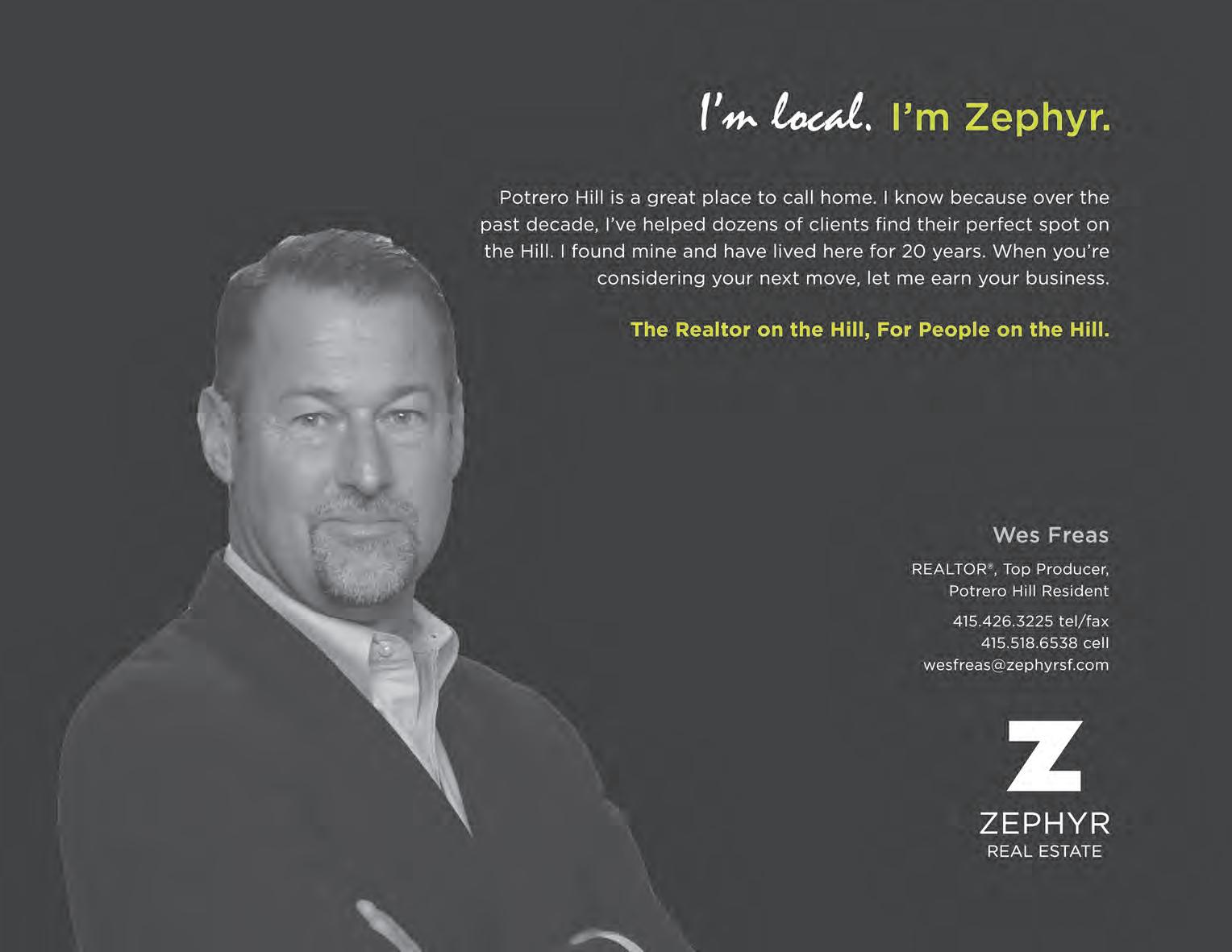
7 THE POTRERO VIEW August 2013
HARRISON
Coupon only valid at checkout. Limit 1 per person. Expires 6/30/13 CALL FOR AN APPOINTMENT TODAY! 450 Connecticut Street San Francisco, CA 94107 (415) 282-9603 www.ACTCM.edu/Clinic


Friends of Jackson Park Launched
BY LIZ MELCHOR
On a Wednesday evening in early July, Ayse Hortacsu waited outside Live Oak School. She was organizing the second meeting of the Friends of Jackson Park, and thought it’d be a small get together. But by 6:30, twenty neighbors had gathered to talk about the public space. At 7 p.m. District 10 Supervisor Malia Cohen arrived at the Live Oak School meeting room to join the conversation.
working on its behalf. While Jackson Park did receive $300,000 worth of work this year to resurface the tennis and basketball courts and add lighting – paid for with general fund monies – it has yet to be earmarked in any park bonds. And up until Hortascu founded Friends of Jackson Park, no neighborhood group had adopted it.
Another meeting to discuss the park wil be held on August 1, again at Live Oak School.
The July turnout was in stark contrast to the first get-together to discuss the park Hortascu had hosted in February, which had attracted just one other attendee. Hortascu and a growing number of residents are concerned that Jackson Park has been neglected compared to other Hill green spaces. At the Potrero Hill Recreation Center, the City recently installed a new playground, and has set aside more than $4 million from the latest park bond for further renovations. McKinley Square Park has at least two supporting groups
Hortascu speculated that there hasn’t been the same interest in Jackson Park because it’s not surrounded by residential properties. But as a mother of four year old Selem and a one year old, who lives three blocks from the green space, this was her park of choice. When she signed up Selim for a basketball league that met in the clubhouse and saw the kitchen inside she thought it was a shame that the facility wasn’t open to the public and was in poor condition.
Broader community interest in the park was sparked by a handful of recent incidents involving hypodermic needles found at the playground. One of the meeting attendees, Hill resident Megan Sheedy, found three needles at the playground on June 12th. On June 22nd, Arkansas Street resident Jill Davis was at the park when a child playing with her eleven-month old, Jackson, found a needle in the sand. A third child was brought to the hospital
that day after being pricked with the needle.
At last month’s gathering these incidences was fresh on the attendees’ minds. Hortascu had invited Steve Cismowski, a park services manager for the San Francisco Department of Parks and Recreation, Bayview Station police captain Robert O’Sullivan, and Joyce Book, founder of Friends of McKinley Park, to speak to the group. “Fortunately this is the first incident at the playground, although that is still one too many,” O’Sullivan said. He added that police have been walking the park at night since the incidents.
“What is the possibility of swapping out sand with the new rubber material? What would it cost?” asked a father
attending the meeting. Cismowski explained that Jackson Park hadn’t been earmarked in the 2012 bond, and would need to get money to support any changes through the Playground Initiative or Community Opportunity Fund, competitive funding programs that are available to all City parks. “Supervisor Cohen is a really good resource,” Cismowski said. “Usually the supervisors get what they want.” Organizing “…is the surest way to ensure that your park gets looked after,” Cismowski said later.
When the supervisor arrived at the meeting attendees asked for her support. “I can be quietly helpful,” said Cohen said. “We can be partners.”
“From what we now understand, being quietly helpful would be very helpful,” chimed in an attendee.
Book explained how a neighborhood group can be organized to effectively work with the park’s department. “What you really need to figure out now is what do I want today and what do I want long-term,” said Book.
“I want fig trees, lemon trees, a rainforest,” Davis said, laughing. “But I’ll take some new sand tomorrow.”
Another meeting to discuss the park will be held on August 1, again at Live Oak School. “I want to keep up the momentum,” Hortascu said. One attendee agreed to help with outreach; another is working on a Facebook page. “I am feeling very optimistic,” said Davis.
The Healthy Generations Project (HGP) is in full swing with Community Health Leaders conducting parent/ child reading and play groups and a daily Walking School Bus to support children in getting to school on time starting in August!
What is the Healthy Generations Project?
The Healthy Generations Project (HGP) is a pilot program in Potrero Terrace and Annex that helps parents of children 0-5 years old to build resiliency against Adverse Childhood Experiences (ACE). Through a peer-to-peer model, HGP utilizes the latest information about the impacts of stress on children’s cognitive, emotional, mental and long-term physical health, to strengthen parent/child relationships and provide parents with education, emotional support and opportunities to build resiliency through ongoing parenting activities. Over time this will result in increased levels of kindergarten readiness, academic proficiency, school attendance and other long term health benefits for Potrero children.
Why it’s important
The most important developmental period in a person’s life occurs between infancy and age 51. Science shows that there is a high correlation between Adverse Childhood Experiences (ACEs) and negative adult outcomes, including low educational attainment and chronic diseases. The HGP is designed to encourage parents to take an active role in protecting and promoting their child’s developmental health. Providing secure parenting relationships and a healthy community environment for a young child is critical to ensuring life-long success in learning and health.
1 http://www.who.int/mediacentre/factsheets/fs332/en/index.html
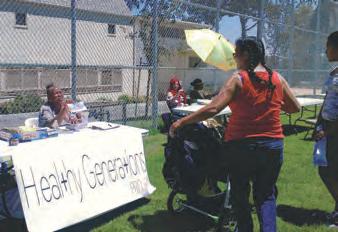
How we do it
HGP offers a 10-week educational workshop series, provides opportunities for social cohesion and mental health service connections, and hires Community Health Leaders to organize parenting activities that help build cognitive and emotional resiliency to ACEs. Parenting activities are grounded in the following 5 Protective Factors:
1. Provide healthy nutrition; 2. Stimulate brain activity; 3. Ensure toxic-free environments; 4. Create positive community and home interactions; and
5. Put education first
HGP understands that parenting practices are personal, cultural and passed on from generation to generation. HGP strives to be a culturally competent program that encourages lasting parenting behavioral changes and healthier outcomes for the Potrero Terrace and Annex community.
For more information, visit our website at rebuildpotrero.com or e-mail us at potrero@bridgehousing.com
8 THE POTRERO VIEW August 2013
LIZ MELCHOR
A MONTHLY UPDATE SPONSORED BY BRIDGE HOUSING VOLUME 35 • AUGUST 2013
ADVERTISE IN THE VIEW’s CLASSIFIED ADS
Supervisor Malia Cohen Assesses the First Half of Her Term
BYBILL SLATKIN
“I continue to be surprised every day,” said Malia Cohen, who is roughly two-and-a-half years into her term on the San Francisco Board of Supervisors, representing District 10, which spans Potrero Hill, Dogpatch, Bayview-Hunters Point, India Basin, Silver Terrace, Visitacion Valley, Little Hollywood, and Sunnydale. “One surprise is the number of citizens who participate in their communities. Many of my constituents want to be involved and to contribute. That’s usually a good thing,” said Cohen.
“Another thing that surprised me is what it takes to make the Board of Supervisors work. It’s amazing the way legislation can get watered down in order to get the support it needs to pass. And my colleagues on the board can surprise you…that they can take positions that aren’t necessarily consistent with their ideologies. Sometimes that‘s good, when
her ten colleagues was an ordinance, co-sponsored with Mayor Ed Lee, outlawing the sale of certain kinds of ammunition, and a bill requiring firearms dealers – of which there’s one or two in the City – report to the police chief any San Franciscan who orders 500 rounds or more of ammunition. Both were passed earlier this year.
Cohen took her stand on weapons and ammunition control to Sacramento, where she testified before the California Senate on behalf of a measure sponsored by Mark Leno (D-S.F.) that would have enabled San Francisco and Daly City to decide whether or not to host gun shows at the Cow Palace. According to Leno’s office, the bill is “making its way through the legislative process.”
“A key component of advocating for District 10 and the needs of the City as a whole is making sure that our state and federal delegations hear from us.”
— Malia Cohen
people depart from their rigid ideology… I’ll need five members—sometimes seven members—to support my programs. So I need to accept amendments. I’m learning to broaden the tent,” Cohen said.
Among the legislation Cohen has introduced to unanimous support from
Cohen also was part of a San Francisco delegation to Washington, D.C. that advocated for passage of ill-fated federal legislation that ultimately was boiled down to a requirement for gun purchasers to submit to background checks. “I share the severe disappointment of our Congressional delegation that Congress did not support comprehensive, smart, gun control efforts. We’re doing everything we can on a local level to address gun violence, but we need the leadership of our federal elected leaders,” said Cohen, whose district has one of the highest rates of gun violence in the City.
Cohen received less support from colleagues on an ordinance, co-spon-
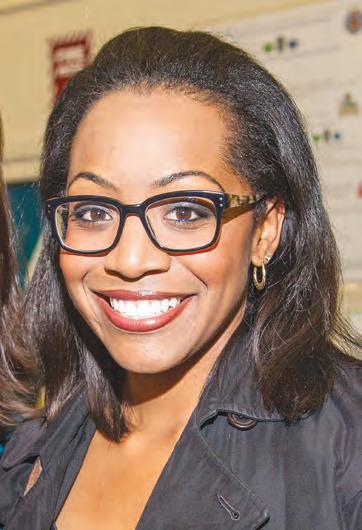
sored by then-Supervisor Carmen Chu, prohibiting on-street parking by oversized vehicles – more than 20 feet long, seven feet high – during nighttime hours, including on Iowa Street under the 280 freeway. The public safety measure passed with six votes. The Cohen legislation that received the most media coverage, banning limited services pregnancy centers from making false or misleading statements to the public about pregnancy related services, was passed by the Board, with one supervisor excused from voting. The intent of the ordinance is to discourage pregnancy service agencies that have an anti-abortion agenda from failing to disclose that ideology when
they promote their “pregnancy care” services.
Along with occasional disappointment about the non-cooperation of colleagues on City business, Cohen expressed frustration over constituent requests that she cannot satisfy. “I’m learning I need to be patient with people who make demands on me that I can’t do anything about. ‘No, I can’t get your kid into a specific school. You can go to members of the school board, but they probably can’t do that either.’
“Plus there are demands in the area of land use, about whether a project should be built. I give people the facts and sometimes they don’t like the answers. Once in a while, I’ve had people act rude and disrespectful when I explain the realities of a situation: that yes, the developer is complying with height limitations, or that the time-window for community input is no longer open.”
“I’d like there to be a website that people could go to for information when they see a project being built and they want to know what it is, when it is supposed to be ready, who is behind it, and also what the dates are; the opportunities to have a say about what is being built.” Cohen also would welcome a system of gathering her constituents’ opinions about issues under debate, as well as their own concerns. “I’d like to use Survey Monkey to collect public opinion. Maybe that’s something the View could help with.”
SUPERVISOR COHEN page 18

9 THE POTRERO VIEW August 2013

services that are currently only available north of Market Street. Kaiser has been searching for the past three years for a location that would better serve its Southside members. Asked whether the company is considering locating a medical complex in Bayview, Randy Wittorp, public affairs director for Kaiser Permanente San Francisco, said that the provider has other Bay Area construction projects, and isn’t looking for additional expansion sites.
According to Wittorp, the Owens Street facility will provide the same services as were planned for 16th and Mississippi streets. But unlike the plan for Potrero Hill, the Mission Bay location will be only a medical complex, excluding residential housing and park-
ing. A parking garage already exists near the Owens Street location; Kaiser will purchase spaces in that garage for staff and patients. In addition, the Mission Bay complex will have more space; 210,000 square feet versus the 190,000 square feet that was planned for the Corovan site.
1600 Owens Street is just west of the University of California San Francisco’s (UCSF) Mission Bay campus.
Owens Street, which runs mainly north and south, intersects with 16th Street just east of Interstate 280. North of Kaiser’s planned office complex, Owens Street turns westward to connect with Seventh and Berry streets. The Owens Street location is three to four blocks from the UCSF-Mission Bay Metro stop


along Third Street.
Save the Hill supporters favor an adaptive reuse of the 16th and Mississippi streets buildings, now that Kaiser has chosen a different location, pointing to companies like Orton Development, which is redeveloping a former shipyard in Dogpatch. According to Askenasy, Corovan location could serve as a “gateway” into Potrero Hill. Askenasy called the buildings located at the site “stunning,” while Minott said they “could be an iconic landmark.”
On behalf of Save the Hill Minott commended District 10 Supervisor Malia Cohen, for her work behind the scenes to change Kaiser’s mind about the location. “She was really instrumental in this,” Minott said.
“This is a testament to the significant hours of work that we have
all put into evaluating their proposal and participating in the planning process,” said Cohen, by email. “This is an example of what can happen when neighbors and myself work together to shape the change that is coming to our Southeastern neighborhoods. I am confident that Kaiser will still be able to meet their goals of increasing access to healthcare services to the Southeastern neighborhoods in a location that is more appropriate for this use.”
Minott also thanked “…Kaiser for changing their thinking about the Potrero Hill site and relocating to a property more appropriate and far better suited for an institutional high volume medical office complex. The relocation is a win-win solution for both Potrero Hill and Kaiser that avoided a long, messy fight.”




www.pdma-sf.org

10 THE POTRERO VIEW August 2013
Join us for our monthly general membership meeting every second Tuesday 9:45-11:00 a.m. at Goat Hill Pizza 1459 18th Street #105 San Francisco 94107 415.779.4107 Visit our new WEB SITE and like us on Facebook for a chance to win a $50 GIFT CERTIFICATE to any of our 150+ member businesses! KAISER from cover
ST. LUKE’S WOMEN’S CENTER MEET & GREET Meet our expert team of certified nurse midwives and physicians and learn more about our services: • Family centered prenatal care • Group prenatal care • Low intervention childbirth practices (personal preferences respected) • Continuity of care (pre-conception through postpartum services) sutterhealth.org Having a baby? Looking for a midwife/OB practice? The Women’s Center at St. Luke’s can help. Monday, September 16 6 p.m. to 7 p.m. St. Luke’s Campus California Pacific Medical Center Griffin Room, 1st floor 3555 Cesar Chavez Street San Francisco Call 415-641-6911 for more information and to reserve your space cpmc.org/stlwomen PHOTO CREDIT
Potrero Hill Housing Bulking Up
BY OMAR KHAN
New construction in Potrero Hill and Dogpatch increasingly features supersized homes and high-density residential complexes. According to Dick Millet, a long-time Potrero Boosters member, who currently serves as the community group’s vice president, developers frequently try to max out their projects. Despite a 40 foot height limit, for example, developers often apply for height exemptions. “If you need exemptions, you’re just not very good,” said Millet, an architect by trade.
Millet - who lives in the six-unit building he owns near 18th and Connecticut streets - pointed to the corner of De Haro and Southern Heights as one example of the supersize phenomenon. The owners of the long-vacant lot - which was purchased from the Potrero Hill Neighborhood House a couple of years ago - want to build a two-unit building that would rise 68 feet, disrupting a neighbor’s views. “It’ll be so out of character for the neighborhood,” said Millet, who has experienced firsthand the ill-effects of a changing neighborhood skyline. “I used to have a panoramic view from my house…now I can’t even see Berkeley. Views are not protected in San Francisco.”
The De Haro and Southern Heights project, however, is dwarfed by a largescale complex being developed by the San Francisco Giants, who are leasing San Francisco Port property at Mission Rock, on which they plan to erect a residential and commercial complex.
The proposed project would include two towers rising more than 350 feet high; 31 stories. “It’s just too high for a building on the waterfront,” said Kenneth Sotto, a local business owner who used to live South-of-Market. It’ll totally change the look of the area.”
Hill and Dogpatch residents are concerned about more than blocked views, with parking another contentious issue. In a City with already tight parking options, many Southside developments are exempt from enforceable minimum parking requirements. Municipal land use reforms adopted in 2006 eliminated parking requirements for housing developed in areas zoned as C-3 commercial. In parcels outside this zoning designation, developers often opted for the minimum 1 to 1 ratio of parking spaces per unit. “A 20 unit building would require 20 parking units,” said Millet. “Minimum parking used to be required, now there is a maximum parking limit.”
Residents living next to new large developments may also face privacy issues, with multiple windows peering into adjacent homes. And new buildings’ appearances often fail to conform to the neighborhood’s colorful style. “A lot of the colors they use are dirty colors: dark brown, olive green. San Francisco is not about dark colored buildings!” exclaimed Millet, who also criticized developers’ choice of building materials, which can consist of industrial-style corrugated and other metals. “Sometimes it works, sometimes it doesn’t,” he said.
Keith Goldstein, who serves as the Potrero Dogpatch Neighborhood Association president, first came to the Hill in 1974. Ten years later he bought his first house on a prime spot for $180,000. This summer, three nearby homes each sold for more than $3 million, including 761 Kansas, a 3,500 square foot modern home. Last spring 901 De Haro Street - a 8,000 square foot compound that belonged to the late art dealer Allan Stone, noted for representing Wayne Thiebaud - was put up for sale. Stone, who died in 2006, enjoyed unobstructed views of the Bay Bridge. The compound includes a 1,200 square foot guesthouse. Stone purchased it in 1987 for $575,000, and made a variety of lighting improvements. It’s listed for $5,995,000.
“Potrero Hill is now like Pacific Heights. Buy a home for way over a million, knock it down and spend another $1 million on renovations,” said Goldstein. “Like many other areas of the City, the Hill is not affordable for middle class families.”
Even with the high prices, the Hill seems to be in the midst of a baby boomlet, as evidenced by an increase in the number of strollers plying 18th and 20th
streets. “Younger people have more money nowadays.” said Millet.
“I was standing on 17th and Rhode Island when I saw a Tesla roll by,” said J.R. Keppler, newly elected Potrero Boosters president, “20 seconds later along came a Ferrari. There’s definitely a lot more young folks, more strollers, more kids.”
“For most of the 70s, 80s, 90s, there were very few families moving up here,” said Goldstein. “I don’t see how young families can continue to purchase homes here in the current frenzied market.”


11 THE POTRERO VIEW August 2013
341Mississippi Street

Beautiful, Sunny Victorian Home
Awash in light from its expansive bay windows, this sunny home is on the coveted North Slope very near 18th Street.
On the market for the first time in over twenty-five years, this beautiful Victorian home has been thoughtfully updated for modern living while retaining its wonderful period detail and soaring ceilings. Ideally–configured for entertaining, the home’s main level boasts an expansive living room, formal dining room, and chef’s kitchen which opens onto a sunny deck overlooking an exquisite garden. The main level is completed by a family room, full bath and laundry.
Upon ascending an ornate staircase you’ll find four bedrooms, a master bath and office. The spacious garage offers parking for two cars and potential to expand the home. Very convenient to Live Oak School, Daniel Webster Elementary and the shops and cafes of the North Slope.
For more information and showing schedules, please visit www.341Mississippi.com.
This beautiful home will be available to view beginning Saturday, July 27.
Price Available Upon Request
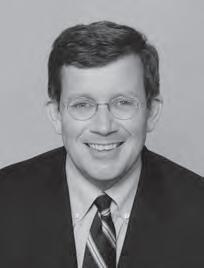
12 THE POTRERO VIEW August 2013 TIM JOHNSON Paragon Real Estate Group DRE# 01476421 415.710.9000 tim@timjohnsonSF.com www.timjohnsonSF.com
A Potrero Hill Perspective on the Protests in Turkey
BY LIZ MELCHOR
In the wake of civil unrest in Turkey, the View asked Irfan Yalcin, the Turkish owner of Pera, about the situation in his home country.
PV: How would you explain the political situation in Turkey?
Yalcin: I am very proud of what is happeaning in Turkey right now. The people are standing for basic human rights. It all started with the five trees. Imagine they want to tear down Central Park and build a big mall there, and you know that the mall is going to benefit some of the prime minister’s or president’s cousins. So people went there, built tents and said, we want to protect our 300-year-old trees. Then at five in the morning they come, they start beating you really bad and drive you out of the park. So that was the spark that started it all.
The protestesters just want a better world. They want more freedom.
The same government has been ruling 12 years now in Turkey, with the same prime minster (PM), Recep Tayyip Erdoğan. Turkey is doing very well economically, but lately the PM has become very totalitarian. He thinks that he has a right to tell people what to do, and that he knows best for the people. He started
banning alcohol sales after 10 o’clock; telling people about education [referring to recent educational reforms that added four years to compulsory education and increased religious instruction in schools.] All these things keep adding and adding. The park was like a spark. People now have started standing and saying, “we want some respect and we want basic human rights. We want to live life as we want.”
PV: Have your family and friends in Turkey been involved in the protests?
My family lives in Ankara and I have cousins who participate. The three places that there are the most demonstrations happening are Istanbul, Ankara, and the third biggest city, Izmir. So in Ankara my cousins were going every day. But in the last two weeks they only have been going on the weekends. But in Istanbul, I have a friend who would go to the park everyday after work and spend the night there. She actually used to live in Potrero Hill and worked at Chat’s coffee; that is how I met her. She moved back to Turkey. I have been texting with her and calling her to see what is happening. I wanted to be helpful, so I sent gas masks. That is what they really need. I sent a dozen gas masks. But she isn’t camping in the park anymore because they have now closed the park.
PV: What else did she tell you about living in the camp?

It is like a dream world. The best thing about the protest is that they never allowed any political movements to come and take over. In Turkey, there are five or six big political parties. The protesters said, “no, we don’t want a political party. We are here for the basic change.” They realized that if a political party got involved it would be different, because then everyone has a different political agenda. So they said, “stay out of this. If a communist wants to join fine, a nationalist fine, but we all have to talk the same about what we want without violence and we have to listen to each other.”
PV: Does what’s happening in Turkey remind you of the Occupy movement or the Arab Spring?
Egypt coverage for six hours, but they will not show what is happening in Istanbul. That is how they close their eyes. They want to make people think that nothing is happening.
When I told my parents after the first week, they didn’t know anything, because they don’t use the computer. They are in Turkey, and they don’t know anything about what is happening. It is about how they connect to the world. They don’t have Twitter and Facebook. All they do is watch some TV, and the news wasn’t telling anything.
PV: How do your parents feel about the protests now that they know about them?
• check brakes, brake lines and hoses
• rotate tires and inflate as needed • refill wiper fluid
• inspect accessory belts for wear
• test 12-volt battery




Occupy Wall Street is very similar. The young people, they just want to have a better world. It is very simple. We all want that. But the government that took over Turkey has made a system where their own people became multi-billionaires and they own all the companies. Everything is material now. The protesters just want a better world. They want more freedom. I mean, they tried to build a mall there. A shopping mall means nothing. It means just standing around, but it has no feelings. But the park has feelings; you can go to the park and sit there. There is more ability to connect to the world in the park.
PV: What do you think about the media coverage of the protests in Turkey?
Of course in the first three days there was nothing on the TV. Everything was on Facebook and Twitter. I was reading an article about just how powerful Twitter and Facebook are. You can control the media, but you cannot control Twitter and Facebook. Now, everyone is media by themselves. They can post something, and you know, and very fast.
PV: Do you think the protests wouldn’t have gotten this big without Facebook and Twitter?
No, not at all. Cause the media didn’t show anything for three days. Even now, I have Turkish TV here and when I turn it on, they will show live
My parents voted for this PM, but they hate violence. So now they don’t like him because of the violence against the people. Look, you can’t justify violence against people who don’t have anything in their hands. The protestors have been non-violent. So far the government has killed four people, and twelve people have lost their eyes. You cannot justify violence using any religion in the world. No way. What are you going to tell the people?
PV: Are you sad that you aren’t in Turkey right now?
I was planning to go to Turkey two weeks ago because it is a once and a lifetime thing. But now because they closed the park and you can only go on the weekends, I changed my plans. But I mean, it is not over, because the current PM is stubborn, but the young people are more stubborn.
PV: Has the Turkish community in the Bay Area been doing things in support of the protests?
We do. Like last Saturday we were in Union Square, and the first two weeks we were in Civic Center. There is a bigger Turkish community in the South Bay, so every weekend there is a rally here and one in Palo Alto. This weekend at Hotel Monaco there is a meeting to talk about how to help. Basically how we can support them; what can we send. It was one of my main things, when it started, was how to support the protesters. We have to look at more. We have to help these people.
13 THE POTRERO VIEW August 2013
LIZ MELCHOR • change oil and filter
struts
pan
• road test for general handling, steering, engine power, transmission performance and clutch operation Acura. Honda. Hyundai. Infiniti. Kia. Lexus. Mazda. Nissan. Scion. Subaru. Toyota. Hybrids. For ALL Potrero View Readers, we will: Community Enginuity Enjoy the Dog Days of Summer. Get out and about! patsgarage.com 1090 26th St. at Indiana St. 415.647.4500 in the Dogpatch Third Street Corridor off Hwy 280 value $152. standard oil now $ 80. $182. synthetic oil now $110. Bring in this ad for a chance to win a custom Rickshaw Bag! rickshawbags.com CMYK Green (20, 2, 95, 0) Red (0, 90, 95, 0)
• check transmission fluid • inspect cooling system • check axle boots • check exhaust system • check rear shocks and front
• inspect oil
gasket
Technology Company Moves to Kansas Street
BY KEITH BURBANK
Earlier this summer OPSWAT moved from South Beach to a former Anchor Brewing location at 398 Kansas Street. OPSWAT develops software that helps companies ensure that their computers comply with security policies, and provides multiple antivirus protection. OPSWAT’s clients include Cisco Systems, Juniper Networks, and the United States Army.
“We are excited about our new facilities, and are looking forward to the stores and restaurants for lunch in Potrero Hill,” said Elisse Lockhart, marketing manager, OPSWAT. “We’re excited about the neighborhood and looking forward to being here and growing here.”
Founded in 2002, OPSWAT moved to the Hill in search of more office space; its new building has twice as much room. During the next six months, the company plans to hire software engineers, project managers, and a few new sales associates. According to Lockhart, even after a decade in business, the company still operates as a start-up, with more engineers than other types of employees.
OPSWAT occupied its South Beach location for almost five years. Most of the company’s 55 employees find the new location equally accessible as the old. OPSWAT encourages its employees to bike to work – offering shower facilities – and many do.
OPSWAT occupies a two-story red brick building at the corner of 17th and
Kansas streets, with windows that make for a pleasant working environment, Lockhart said. The floor plan is open to encourage people to talk to and bounce ideas off of one another. “We want to make it a very collaborative environment,” Lockhart said.
The building’s interior is a mix of modern and vintage. The red brick that makes up the exterior is visible on the interior, while glass walls encapsulate the conference rooms on both floors. Visible from the first floor are the second floor’s wooden floor joists and floor boards. Also visible inside are the structure’s white steel framing beams and heating ducts, which are painted black.
The company’s employees tend to be in their early thirties, and hail from a number of different countries. “We’re fairly international,” Lockhart said. According to Lockhart, OPSWAT’s staff is enthusiastic about their new Hill location because of the influx of new businesses, restaurants and stores in the last few years. It’s “an exciting place to be because of that growth,” Lockhart said. Lockhart is happy about having a Whole Foods Market one block away; other employees are enjoying the area’s restaurants.
OPSWAT is looking to volunteer in the neighborhood. “We’re looking for ways that we can help, possibly based on our expertise in software development,” Lockhart said. “We would love to help community members who want to learn about software development.”
OPSWAT is led by president and
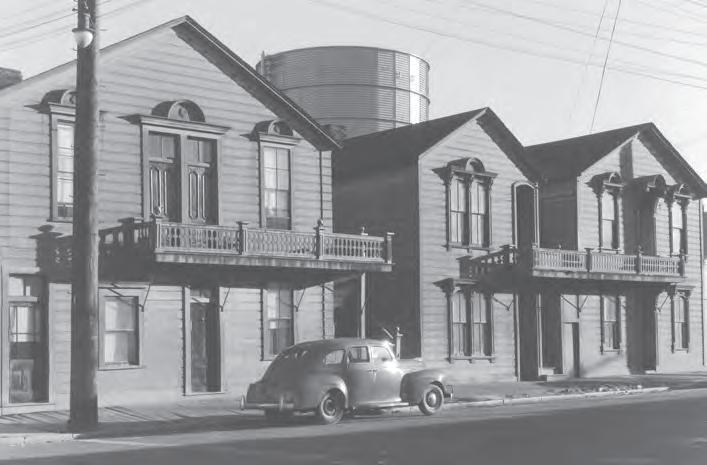
View from the Past
Noted photographer Minor White, co-founder with Ansel Adams of the nation’s first fine arts hotography department at what is today the San Francisco Art Institute, took this photo in 1951. These houses – on the south side (odd-numbered 900 block) of 22nd between Minnesota and Indiana – were built circa 1890, for working-class families whose livelihoods depended on the many industries in the Dogpatch neighborhood. I showed this picture to an architectural historian who, much intrigued by it, had this to say: “The buildings exhibit some architectural features not typically seen on San Francisco Victorians, such as the deeply cantilevered balconies and the narrow, double-height doorways. The buildings are constructed of wood, and feature rustic channeled siding . . . and decorative elements such as the arched window heads. Note the many curiosities: the wood plank sidewalk, the skinny (inadequate!) supports below the balconies, and the balcony on the right that seems to span two separate structures.” The Pacific Gas and Electric Company gas holder – tank – looming behind the homes appears to be in their backyard, but was actually two blocks away, on Pennsylvania Avenue. What WAS in their backyard was the venerable Tubbs Cordage Ropewalk, but its heyday was pretty much over; all that remains of Tubbs today are some reminders of its former diagonal presence on the landscape, and a stub of an eponymously named street. By 1975, SF Muni had taken over this site; its Woods Division occupies it today. The gas tank, erected in the1940s or thereabouts, stood 386 feet high, with a capacity of 17,000,000 cubic feet (!), was demolished in 1989.
– Abigail Johnston, Potrero Hill Archives Project


chief executive officer, Benny Czarny, who has more than 18 years of experience “successfully identifying market needs and building, marketing and sell-
ing innovative products and solutions,” according to the company’s website. “We love this neighborhood,” said Czarny. “It’s nice here.”


ANOTHER BIG PLUS SAME DAY APPOINTMENTS
Northern California’s top primary care doctors and specialists. Plus, you have access to same day appointments at many neighborhood locations. All with online medical records, prescription renewals, lab results – even instant physician messaging. It’s another way we plus you.


14 THE POTRERO VIEW August 2013
FINd A LoCAL Sutter doCtor 1-888-699-doCS (3627) sutterpacific.org
Welcoming Will Holt, M.D. Sutter Pacific Hepatologist
DON NOLTE
COURTESY OF THE CALIFORNIA HISTORICAL SOCIETY AND THE TRUSTEES OF PRINCETON UNIVERSITY




 BY KEITH BURBANK
BY KEITH BURBANK




















































